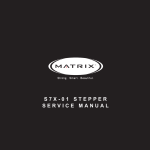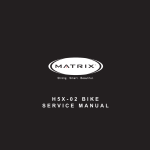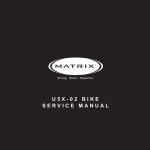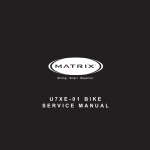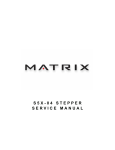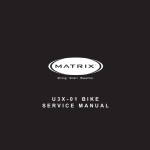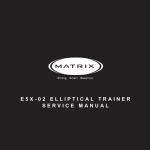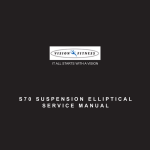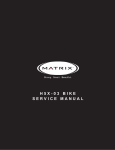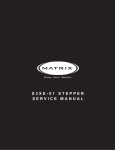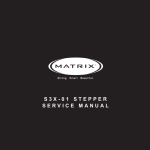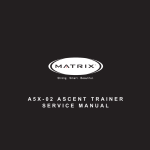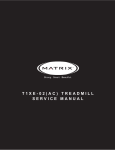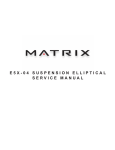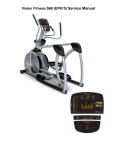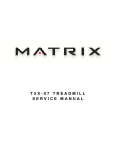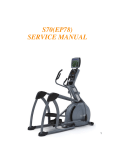Download R3X-02 BIKE SERVICE MANUAL
Transcript
R3X-02 BIKE SERVICE MANUAL TABLE OF CONTENTS CHAPTER 1: SERIAL NUMBER LOCATION . .................................................................. 1 CHAPTER 2: IMPORTANT SAFETY INSTRUCTIONS 2.1 2.2 Read and Save These Instructions . .......................................................................... 2 Electrical Requirements ............................................................................................. 3 CHAPTER 3: PREVENTATIVE MAINTENANCE 3.1 3.2 3.3 Recommended Cleaning Tips . .................................................................................. 4 Check for Damaged Parts ......................................................................................... 4 Care and Maintenance Instructions ........................................................................... 5 CHAPTER 4: CONSOLE OVERLAY AND WORKOUT DESCRIPTION 4.1 4.2 4.3 4.4 4.5 4.6 Console Description ................................................................................................... Workout Setup Steps - Manual................................................................................... Workout Setup Steps - Level Based........................................................................... Workout Setup Steps - User Defined.......................................................................... Workout Setup Steps - Heart Rate Control................................................................. Workout Setup Steps - Constant Watts...................................................................... 6 7 7 7 8 8 CHAPTER 5: MANAGER MODE 5.1 5.2 Using Manager Mode ................................................................................................ 9 Manager Mode Overview............................................................................................ 9 CHAPTER 6: ENGINEERING MODE 6.1 Using Engineering Mode............................................................................................. 10 CHAPTER 7: SERVICE MODE 7.1 Using Service Mode.................................................................................................... 11 CHAPTER 8: TROUBLESHOOTING 8.1 8.2 8.3 8.4 8.5 8.6 8.7 8.8 8.9 8.10 8.11 8.12 8.13 8.14 8.15 Electrical Diagram ...................................................................................................... Error Codes on the Console....................................................................................... LCB LED Indicators.................................................................................................... Display Power Issues.................................................................................................. Error 0x04A0............................................................................................................... Keypad Issues............................................................................................................. Resistance Issues....................................................................................................... Pedal Slipping............................................................................................................. Noise Issues................................................................................................................ Heart Rate Issues....................................................................................................... Seat Issues................................................................................................................. Entertainment Troubleshooting - Overview................................................................. Entertainment Troubleshooting - Picture Fuzzy or Unclear........................................ Entertainment Troubleshooting - TV Will Not Turn On............................................... Entertainment Troubleshooting - Controller Issues..................................................... 12 13 14 15 16 17 18 19 19 20 21 22 23 24 25 CHAPTER 9: PART REPLACEMENT GUIDE 9.1 9.2 9.3 9.4 9.5 Console Replacement................................................................................................. Handlebar Replacement ............................................................................................ Cup Holder Replacement .......................................................................................... Console Keypad / Overlay Replacement.................................................................... Console Mast Replacement........................................................................................ 26 27 28 29 31 TABLE OF CONTENTS 9.6 9.7 9.8 9.9 9.10 9.11 9.12 9.13 9.14 9.15 9.16 9.17 9.18 9.19 9.20 9.21 9.22 9.23 Seat Pad Replacement............................................................................................... 32 Back Pad Replacement.............................................................................................. 33 HR Handlebar Replacement....................................................................................... 34 HR Grips Replacement............................................................................................... 35 Upper Seat Frame Replacement ............................................................................... 36 Lower Seat Frame Replacement................................................................................ 37 Seat Adjustment Handle Replacement....................................................................... 39 Rear Shrouds Replacement........................................................................................ 40 Pedal Replacement . .................................................................................................. 41 Front Shroud Replacement......................................................................................... 42 Lower Control Board Replacement............................................................................. 43 Battery Replacement................................................................................................... 44 Drive Belt Replacement................................................................................................... 45 Generator Belt Replacement........................................................................................... 46 Generator Replacement................................................................................................... 47 Pulley Axle Set Replacement.......................................................................................... 48 Crank Axle Set Replacement........................................................................................... 50 Testing the Bike................................................................................................................ 51 CHAPTER 10: BIKE SPECIFICATIONS AND ASSEMBLY GUIDE 10.1 10.2 10.3 10.4 10.5 10.6 R3x-02 Bike Specifications......................................................................................... Fasteners and Assembly Tools................................................................................... Assembly Instructions ................................................................................................ Adjusting the Pedal Straps and Seat.......................................................................... Leveling the Bike......................................................................................................... TV Bracket Installation................................................................................................ 52 53 54 58 59 60 CHAPTER 11: SOFTWARE UPGRADE GUIDE 11.1 Software Upgrade Procedure..................................................................................... 64 iii CHAPTER 1: SERIAL NUMBER LOCATION 1.1 SERIAL NUMBER LOCATION A serial number plate is located below the bottom of the console mast beneath a rubber boot. There is also a serial number tag on the middle of the main frame pointed towards the floor. 1 CHAPTER 2: IMPORTANT SAFETY INSTRUCTIONS 2.1 READ AND SAVE THESE INSTRUCTIONS To ensure your safety and protect the equipment, read all instructions before operating the MATRIX R3x-02 Bike. To ensure proper use of the Matrix R3x-02 Bike, make sure that all users read this manual. Remind the users that before undertaking any fitness program, they should obtain complete physical examinations from their physicians. If, at any time while exercising, the user experiences dizziness, pain, or shortness of breath, nausea or feels faint, he or she must stop immediately. * This bike is only to be used for its intended purpose described in this manual. Do not use attachments that have not been recommended by Matrix. * Never drop or insert objects into any opening. Keep hands away from moving parts. If the item cannot be reached, contact a Matrix authorized dealer for assistance. * Never operate the unit if it is damaged, not working properly, when it has been dropped, or has been dropped in water. * Keep hands and feet clear at all times from moving parts to avoid injury. * Do not use this product outdoors, near swimming pools or in areas of high humidity. * Do not operate where aerosol (spray) products are being used or when oxygen is being administered. * Do not use this product in bare feet. Do not wear shoes with heels, leather soles, cleats, or spikes while exercising. * Do not remove the side covers. Service should only be done by an authorized service technician. * Close supervision is necessary when used near children, invalids, or disabled people. * When the bike is in use, young children and pets should be kept at least 3 meters / 10 feet away. * Assemble and operate the bike on a solid, level surface. * Never face backward while using the Matrix R3x-02 Bike. * Use the stationary handlebars when mounting or dismounting the bike. * Do not wear clothing that might catch on any moving parts of this bike. 2 CAUTION! If you experience chest pains, nausea, dizziness, or shortness of breath, stop exercising immediately and consult your physician before continuing. CAUTION! Any changes or modifications to this equipment could void the product warranty. CHAPTER 2: IMPORTANT SAFETY INSTRUCTIONS 2.2 ELECTRICAL REQUIREMENTS The Matrix 3x Series Recumbent Bike is designed to be self powered. NOTE: If an add on TV (using a bracket) is added to the unit, it must be plugged in, or the TV will not operate correctly. If the Bike will be plugged in, follow the requirements below. MATRIX DEDICATED CIRCUIT/ELECTRICAL REQUIREMENT INFO All Matrix Bikes require the use of a 15 amp or 20 amp “dedicated circuit,” with a non-looped (isolated) neutral/ground, for the power requirement. Quite simply this means that each outlet you plug Bikes into should not have anything else running on that same circuit besides other Bikes (up to 3 per 15 amp circuit and 4 per 20 amp circuit). The easiest way to verify this is to locate the main circuit breaker box, and turn off the breaker(s) one at a time. Once a breaker has been turned off, the only thing that should not have power to it are the Bikes in question. No lamps, vending machines, fans, sound systems, or any other item should lose power when you perform this test. Non-looped (isolated) neutral/grounding means that each circuit must have an individual neutral/ground connection coming from it, and terminating at an approved earth ground. You cannot “jumper” a single neutral/ground from one circuit to the next. In addition to the dedicated circuit requirement, the proper gauge wire must be used from the circuit breaker box, to each outlet that will have the maximum number of units running off of it. If the distance from the circuit breaker box, to each outlet, is 100 ft or less, then 12 gauge wire may be used. For any distance greater than 100 ft from the circuit breaker box to the outlet, 10 gauge wire must be used. For your safety and Bike performance, the ground on this circuit must be non-looped. Please refer to NEC article 210-21 and 210-23. Your Bike is provided with a power cord with a plug listed below and requires the listed outlet. Any alterations of this power cord could void all warranties for this product. Multiple Bikes can be powered on one dedicated circuit. (3 units per 15 Amp and 4 units per 20 Amp dedicated circuit.) GROUNDING INSTRUCTIONS: The Matrix R3x-02 Recumbent Bike must be grounded. If it should malfunction or break down, grounding provides a path of least resistance for electric current to reduce the risk of electric shock. The Bike is equipped with a cord having an equipment grounding conductor and a grounding plug. The plug must be plugged into an appropriate outlet that is properly installed and grounded in accordance with all local codes and ordinances. If the user does not follow these grounding instructions, the user could void the Matrix limited warranty. DANGER: Improper connection of the equipment grounding conductor can result in the risk of electric shock. Check with a qualified electrician if the user is in doubt as to whether the product is properly grounded. Do not modify the plug provided with the product if it will not fit the outlet, have a proper outlet installed by an electrician. 3 CHAPTER 3: PREVENTATIVE MAINTENANCE 3.1 RECOMMENDED CLEANING TIPS Preventative maintenance and daily cleaning will prolong the life and look of your MATRIX R3x-02 Bike Please read and follow these tips. *Position the equipment away from direct sunlight. The intense UV light can cause discoloration on plastics. *Locate your equipment in an area with cool temperatures and low humidity. * Clean with a soft 100% cotton cloth. *Clean with soap and water or other non-ammonia based all purpose cleaners. *Wipe seats, pedals, console, heart rate grips, and the handlebar clean after each use. *Do not pour liquids directly onto your equipment. This can cause damage to the equipment and in some cases electrocution. * Check pedal straps weekly for wear. * Adjust leveling feet when equipment wobbles or rocks. * Maintain a clean area around the equipment, free from dust and dirt. 4 3.2 CHECK FOR DAMAGED PARTS DO NOT use any equipment that is damaged or has worn or broken parts. Use only replacement parts supplied by Matrix Fitness Systems. MAINTAIN LABELS AND NAMEPLATES. Do not remove labels for any reason. They contain important information. If unreadable or missing, contact Matrix Fitness Systems for a replacement at 866-693-4863 or www.matrixfitness.com. MAINTAIN ALL EQUIPMENT. Preventative maintenance is the key to smoothly operating equipment. Equipment needs to be inspected at regular intervals. Defective components must be kept out of use until they are repaired. Ensure that any person(s) making adjustments or performing maintenance or repair of any kind is qualified to do so. Matrix Fitness Systems will provide service and maintenance training at our corporate facility upon request or in the field if proper arrangements are made. CHAPTER 3: PREVENTATIVE MAINTENANCE 3.3 CARE AND MAINTENANCE INSTRUCTIONS In order to maximize life span, and minimize down time, all MATRIX equipment requires regular cleaning, and maintenance items performed on a scheduled basis. This section contains detailed instructions on how to perform these items and the frequency of which they should be done. Some basic tools and supplies will be necessary to perform these tasks which include (but may not be limited to): * Metric Allen wrenches * #2 Phillips head screwdriver * Adjustable wrench * Torque wrench (capability to read foot lbs and inch lbs) * Lint free cleaning cloths * Teflon based spray lubricant such as "Super Lube" or other Matrix approved products. * Mild water soluble detergent such as "Simple Green" or other Matrix approved products * Vacuum cleaner with an extendable hose and crevasse tool attachment. You may periodically see addendums to this document, as the Matrix Technical Support Team identifies items that require specific attention, the latest version will always be available on the Matrix web site at www.matrixfitness.com. DAILY MAINTENANCE ITEMS 1) Look and listen for loose fasteners, unusual noises, and any other indications that the equipment may be in need of service. 2) Clean the bike before and after each use, including: a. Use a damp, soft cloth with water or mild liquid detergent to clean all exposed surfaces. DO NOT use ammonia, chlorine, or any acid based cleaners. NOTE: Spray cleaner onto a cloth before using, never spray cleaner directly onto the equipment. b. Keep the console display free of fingerprints and salt build up caused by sweat. 3) Attempt to wobble the unit from side to side and front to back. Level if needed (see Section 10.5). WEEKLY MAINTENANCE ITEMS 1) Frequently vacuum the floor beneath the unit to prevent the accumulation of dust and dirt which can affect the smooth operation of the unit. 2) Check the pedal straps for damage. 3) Clean the grooves on the foot pedals. MONTHLY MAINTENANCE ITEMS 1) Inspect the console, seat, pedals, and shrouds for damage. 2) Tighten the pedals onto their respective cranks using a 15 mm wrench. 3) Adjust the leveling feet if equipment rocks or wobbles. 4) Check the seat for looseness. Tighten the seat rollers if needed. YEARLY MAINTENANCE ITEMS 1) Remove the front shrouds and check the belt for damage, alignment, and proper tension. 5 CHAPTER 4: CONSOLE OVERLAY AND WORKOUT DESCRIPTION 4.1 CONSOLE DESCRIPTION WORKOUT KEYS Simple program view and selection buttons. GO: One touch Start. ENTER: To confirm each program setting. UP / DOWN LEVEL: Easy information and level selection. UP / DOWN TIME: Easy information and time adjustment. STOP: Ends workout and shows workout summary data. COOL DOWN: Puts the Bike into Cool Down Mode. TOGGLE DISPLAY: Allows the user to select what information is displayed on each of the 3 windows on the console. Press and hold to enable / disable scrolling. 6 CHAPTER 4: CONSOLE OVERLAY AND WORKOUT DESCRIPTION 4.2 WORKOUT SETUP STEPS - MANUAL GO - Press to immediately begin a workout. Workout, resistance level, and time will automatically go to default settings. Pressing GO will not prompt user for age, weight, or level settings. 1) Start pedaling and press the GO key to begin your workout. 2) The display will read 3, 2, 1, Begin and then the program will start. MANUAL - Manual allows the user to input more information while defining their own workout. Calorie expenditure will be more accurate when inputting information in Manual than by pressing GO. 1) 2) 3) 4) 5) Start pedaling, press the MANUAL key. Select Level by using the UP or DOWN LEVEL keys and press ENTER. Select Time by using the UP or DOWN LEVEL keys and press ENTER. Select Weight by using the UP or DOWN LEVEL keys and press ENTER. The display will read 3, 2, 1, Begin and then the program will start. 4.3 WORKOUT SETUP STEPS - LEVEL BASED PROGRAMS FAT BURN - Fat burn is a level based program that is designed to help users burn fat through various resistance level changes. ROLLING HILLS - The Rolling Hills program is a level based program that automatically adjusts the resistance level to simulate real terrain. INTERVAL TRAINING - The Intervals Training program is a level based program that automatically adjusts the resistance of the machine from low to high intensity settings at regular intervals. 1) 2) 3) 4) 5) Start pedaling, press the workout button of choice. Select Time by using the UP or DOWN LEVEL keys and press ENTER. Select Weight by using the UP or DOWN LEVEL keys and press ENTER. Select Level by using the UP or DOWN LEVEL keys and press ENTER. The display will read 3, 2, 1, Begin and the program will start. 4.4 WORKOUT SETUP STEPS - USER DEFINED PROGRAMS RANDOM - There are 20 workout profiles in Random Mode. The profile will change every time random is pressed. Choose the random workout desire, then start similar to a level based program. FIT TEST - The Fitness Test measures cardiovascular fitness and provides an estimated sub-maximal VO2 result. It based on power output according the ACSM standards and was developed by the Cooper Institute (www.cooperinstitute.com). User RPMs must remain between 60-80 RPM during the test. The test will end when the user can no longer maintain this speed. Use of a heart rate strap is optional, but provides more data. The test starts at a low intensity level and gradually increases in intensity (difficulty) every 2 minutes. As it increases, the user must maintain 60-80 RPM to advance to the next level. The test could take upwards of 30 minutes for very fit individuals. Once the test ends a recovery period (Cool Down) will begin, and the user's results are calculated and displayed. Results are based on the number of stages complete. Stage Complete: 1 Well Below Average 2 Well Below Average 3 Below Average 4 Below Average 5 Average 6 Average 7 Above Average 8 Above Average 9+ Well Above Average 7 CHAPTER 4: CONSOLE OVERLAY AND WORKOUT DESCRIPTION 4.5 WORKOUT SETUP STEPS - HEART RATE CONTROL TARGET HEART RATE - The Matrix Bike comes with standard digital contact heart rate sensors and are POLAR telemetry compatible. The heart rate control workout mode allows the user to program their desired heart rate zone, and the Bike will automatically adjust the level based upon the user's heart rate. The heart rate zone is calculated using the following equation: (220-Age)8%=target heart rate zone. The user must wear a POLAR telemetric strap or continually hold onto the contact heart rate grips for this workout. Locate the metal sensors on the handlebars of the Bike. Notice that there are two separate pieces of metal on each grip. You must be making contact with both pieces of each grip to get an accurate heart rate reading. You can grab these sensors in any program to view your current heart rate. 1) 2) 3) 4) 5) 6) Start pedaling and press the TARGET HEART RATE key. Select Age by using the UP or DOWN LEVEL keys and press ENTER. Select Target HR Percentage by using the UP or DOWN LEVEL keys and press ENTER. Select Time by using the UP or DOWN LEVEL keys and press ENTER. Select Weight by using the UP or DOWN LEVEL keys and press ENTER. The display will read 3, 2, 1, Begin and the program will start. Heart Rate Protocols: - Heart Heart Heart Heart Heart rate rate rate rate rate is is is is is within 10 BPM (beats per minute) of target, upper LED display will show a heart. greater or less than 10 BPM of target, resistance level will increase or decrease every 10 seconds. greater than 14 BPM of target, resistance level will drop to 30%. greater than 10 BPM of target, lower LED will display "WARNING HR ABOVE TARGET". greater than 20 BPM of target, the program will immediately end. 4.6 WORKOUT SETUP STEPS - CONSTANT WATTS CONSTANT WATTS - Constant Watts is a unique program that allows you to vary your cadence or RPM and the machine's resistance will adjust accordingly to your selected goal. The quicker you stride, the less resistance for the goal selected. The braking system is adjustable in normal programs except for Constant Watts. For the Constant Watts program, the braking is not adjustable. 1) 2) 3) 4) 5) 8 Start pedaling and press the CONSTANT WATTS key. Select desired Watts by using the UP or DOWN LEVEL keys and press ENTER. Select Time by using the UP or DOWN LEVEL keys and press ENTER. Select Weight by using the UP or DOWN LEVEL keys and press ENTER. The display will read 3, 2, 1, Begin and the program will start. CHAPTER 5: MANAGER MODE 5.1 USING MANAGER MODE The Manager's Custom Mode allows the club owner to customize the bike for the club. 1) To enter Manager Mode, press and hold down the UP and DOWN LEVEL keys. Continue to hold down these two keys until the display reads Manager Mode and hit ENTER (Figure A). 2) To scroll through the list of options in Manager Mode, use the UP and DOWN LEVEL keys. Each of the custom settings will show on the display. 3) To select a custom setting, press the ENTER key when the desired setting is shown. 4) To change the value of the setting, use the UP and DOWN LEVEL keys. 5) To confirm and save the value of the setting, press the ENTER key. FIGURE A 6) To exit the setting without saving, press the BACK key. 7) Press and hold the STOP key for 3-5 seconds to return to normal operation. 5.2 MANAGER MODE OVERVIEW CUSTOM SETTING DEFAULT MINIMUM MAXIMUM DESCRIPTION Maximum Time 60 min 5 min 99 min Sets the total run time of any program. Default Time 30 min 5 min Maximum Time Setting Workout time when GO is pressed or when no time is selected during program set up. Default Age 30 10 100 Starting age when GO is pressed or when no age is selected during program set up. Default User Weight 150 lbs / 68 kg 60 lbs / 27 kg 400 lbs / 182 kg Weight used for program calorie expenditure calculations. Accumulated Distance N/A 0 99,999 Miles Total distance for all programs. Accumulated Time N/A 0 999,999 hours Total time for all programs displayed in hours. Software Version N/A N/A N/A Current version of console software. Also able to check LCB and radio versions if needed. Sound Mode On On Off Turns the chime on / off when a button is pressed. Out of Order Off On Off Locks the machine when out of order. Gender Male Male Female Determines the gender of the user when not selected during program set up. Language English English English Sets the language for the console. Select between English, Spanish, German, French, Italian, Portuguese, Finnish, Japanese, Swedish, and Dutch. Speed / Distance Mode Mile Mile Kilometer Displays distance in miles or kilometers. Default Level 1 1 20 Starting resistance when GO is pressed or when no resistance is selected during program set up. 9 CHAPTER 6: ENGINEERING MODE 6.1 USING ENGINEERING MODE To enter Engineering Mode, hold the LEVEL UP and DOWN keys for 3-5 seconds until Manager appears on the middle LED display. Press the LEVEL UP or DOWN key to scroll to Engineering. Press ENTER to go into Engineering Mode. 10 CUSTOM SETTING DEFAULT OPTIONS DESCRIPTION Machine Type R3x H3x, U3x, R3x, E3x, S3x, A3x The machine type should be the R3x for the Bike. Power Save Time 30 Seconds 30-60 Seconds Power saving time for the self powered frame. Pause Time 30 Seconds 15 - 120 Seconds For non self powered frames only. Not used on this model. Serial Number N/A N/A Serial Number input is available for both the Console and Frame. Use the number keys and UP / DOWN LEVEL keys to enter Engineering Mode. Due to the limited LED characters, 2 layers are used to enter the serial number. First Layer: - PPPPP V - PPPPP is the product name. - V is the version. If the version is A, just leave this blank. Second Layer - YY MM nnnnn. - YY is the year (11, 12). - MM is the month (e.g. 08, 09, 10). - nnnnn is the actual serial number. Use the UP / DOWN LEVEL keys to navigate the layers and the number keys to input the serial number. The product name is dependent on the Machine Type setting. For example, the console is EP603 with ver. A and the manufactured date is 2011.08 with 98765. The frame is RB91 with ver. A and the manufactured date is 2011.06 with 12345. Their serial numbers are: Console SN: EP603 1rst layer, 110898765 2nd layer. Frame SN: RB91 1rst layer, 110612345 2nd layer. Sleep Time Off Off or On (1-30 Minutes) If there is no use of the machine over a period of time, the console LEDs will turn off (go into sleep mode). This is for AC powered units only. Audio Source Off Off / TV / PC TV / Remote TV Manual setting that sets which outside TV will have audio through the console audio ports. Disable Errors No Yes or No No - Shows A-C class error codes. Yes - Shows only C class error codes. Speed Units Mile Mile or Kilometer Set for Mile or Kilometer. CHAPTER 7: SERVICE MODE 7.1 USING SERVICE MODE To enter Service Mode, hold the LEVEL UP and DOWN keys for 3-5 seconds until Manager Mode appears on the middle LED display. Press the LEVEL UP or DOWN key to scroll to Service Mode. Press ENTER to go into Service Mode. CODE DEFAULT OPTIONS Service 1 Display Test Press the ENTER key repeatedly to check each set of LEDs on the display sequentially. Service 2 Keypad Test Press any key and the display should show the corresponding message. Service 3 Distance / Time Service 4 CSafe / RF Test Press the ENTER key to test CSAFE. Press the ENTER key again to test the RF. Service 5 Error Log Shows the last 10 errors. Press and LEVEL UP and DOWN for 3 seconds to clear the errors. Service 6 Set Date / Time Press the LEVEL keys to move cursor, the number keys to set date / time, and the ENTER key to save. Service 7 Export and Import Parameter Export Parameter - Export all parameters to a USB device. Import Parameter 1 - Imports the engineer parameters to a USB device except serial number, accumulated distance and time. Import Parameter 2 - Imports the engineer parameters to a USB device including serial number, accumulated distance and time. Distance: Mile 0 - 99999 Kilometer 0 - 160898 Time: 0 - 999999 DESCRIPTION Manually sets the Accumulated Distance and Time. 11 CHAPTER 8: TROUBLESHOOTING 8.1 ELECTRICAL DIAGRAMS 12 CHAPTER 8: TROUBLESHOOTING 8.2 ERROR CODES ON THE CONSOLE CODE CLASS DESCRIPTION SOLUTION 0x02AB C Machine type error. Set the correct machine type in Engineering Mode. 0x02B3 C Resistance type error. Set the correct machine type in Engineering Mode. 0x0201 A Low voltage on the battery (voltage under 11.2V). Charge by running or by plugging in the AC adapter. 0x0247 B LCB failed (memory write error / feedback ADC error). Replace the LCB. 0x0248 B Battery failure or disconnection (Voltage under 8V or over 15V). Check the wire connections at the battery. Replace the battery. 0x0441 B When the UCB implements a command, the LCB is not receiving this command. Check the machine type in Engineering Mode. Check the connections at the UCB and LCB. 0x04A0 C Digital Communication Failure. LCB has no return message for the UCB for 3 seconds. Check the console cable connections at the UCB and LCB. Replace the UCB or LCB as needed. 0x04B0 C UCB No Response. Check the console cable connections at the UCB and LCB. Replace the UCB or LCB as needed. CLASS C ERRORS WILL DISPLAY ON THE CONSOLE. CLASS A OR B ERRORS WILL ONLY DISPLAY IN SERVICE MODE 5. 13 CHAPTER 8: TROUBLESHOOTING 8.3 LCB LED INSTRUCTIONS LED INDICATOR DESCRIPTION LED 1 RPM (AC Plug In). LED 2 +5V LED 3 +15V LED 4 Bus Voltage LED 5 RPM (Generator). LED 6 Status 1 (Program operation). LED 7 Status 2 (Resistance value in middle 1/2 VCC). LED 8 Status 3 (Digital Communication). LED 9 +12V (Console Power). WITHOUT AC PLUG - NORMAL LED 2 - LED 9 - On. LED 1 - Off (No AC plug detected). LED 5 - On (Generator power detected), WITH AC PLUG - NORMAL LED 2 - LED 9 - On. LED 1 - On (AC plug detected). LED 5 - Off (No Generator power detected). LED 1 LED 5 14 CHAPTER 8: TROUBLESHOOTING 8.4 TROUBLESHOOTING - DISPLAY ISSUES NO DISPLAY ON THE CONSOLE OR THE DISPLAY IS DIM WHEN RUNNING LED 9 LED 1 LED 8 LED 5 SYMPTOM: The console will not power up or the display is dim. CHECK POINT POSSIBLE ISSUE SOLUTION LEDs 2, 3, 4, 6, and 7 should be ON. If they are OFF, the LCB is damaged. Replace the LCB. If LED1 is OFF. No AC power cord plugged in. Normal for an non-powered unit. If LED 5 is OFF. Generator has no RPM output. Normal for a powered unit. If non-powered and issue is still present, replace the generator. If LED 8 is OFF. Bad communication between UCB and LCB. Reconnect the console cable at the LCB and UCB and check for kinks. If LED 9 is OFF. LCB is not providing 12V power to the UCB. Replace the LCB. SOLUTION IF LEDS ARE NORMAL: 1) If the LEDs are lit normally, replace the UCB and console cable. 2) if the issue is still present after the UCB and console cable are replaced, replace the LCB. 15 CHAPTER 8: TROUBLESHOOTING 8.5 TROUBLESHOOTING - ERROR 0x04A0 ERROR 0x04A0 (DIGITAL COMMUNICATION FAILURE) LED 1 LED 8 SYMPTOM: Error code 0x04A0 is displayed on the console. CHECK POINT POSSIBLE ISSUE LEDs 2, 3, 4, 6, and 7 should be ON. If they are OFF, the LCB is damaged. Replace the LCB. If LED1 is OFF. No AC power cord plugged in. Normal for an non-powered unit. If LED 8 is OFF. Bad communication between UCB and LCB. Reconnect the console cable at the LCB and UCB and check for kinks. SOLUTION IF LEDS ARE NORMAL: 1) If the LEDs are lit normally, replace the UCB and console cable. 2) if the issue is still present after the UCB and console cable are replaced, replace the LCB. 16 SOLUTION CHAPTER 8: TROUBLESHOOTING 8.6 TROUBLESHOOTING - KEYPAD ISSUES ALL OR SOME OF THE FUNCTION KEYS DO NOT RESPOND POSSIBLE CAUSES: 1) The keypad connection ribbon cable has not been plugged in correctly. 2) The keypad is damaged. 3) The UCB is damaged. SOLUTION: 1) Perform a keypad test in Service Mode: a. Press and hold both the UP and DOWN LEVEL keys until Manager Mode appears on the display. b. Use the UP and DOWN LEVEL keys to scroll to Service Mode 5 and press ENTER. c. Test the affected keypad. If the keypad works in the keypad test it may not be a functioning key in the program used for testing it. 2) Check the connections of the keypad at the UCB. a. Remove the console from the console mast. b. Remove the 6 screws holding the back of the console to the front (Figure A). c. Inspect the keypad ribbon cable connection at the UCB (Figure B). d. Even if the keypad ribbon cable appears to be connected correctly, unplug and re-seat the cable. 3) Replace the affected keypad. 4) Replace the UCB. FIGURE A FIGURE B 17 CHAPTER 8: TROUBLESHOOTING 8.7 TROUBLESHOOTING - RESISTANCE ISSUES HIGH OR NO RESISTANCE POSSIBLE CAUSES: 1) 2) 3) 4) The The The The console cable is damaged or not properly plugged in. UCB is damaged. Generator is damaged. LCB is damaged. SOLUTION: 1) Check the console cable connections at the UCB and LCB. 2) Check if the generator is outputting variable power: a. Insert the probes from a multi-meter into the 1 & 2, 2 & 3, and 1 & 3 wires on the generator wire harness connector (Figure A). b. When pedaling, the output voltage from the generator should vary depending on the RPM. The generator should output 120 VAC at 94 RPM. 3) If the generator does not have variable power, replace the generator. 4) If the generator does have variable power, replace the LCB. FIGURE A 18 CHAPTER 8: TROUBLESHOOTING 8.8 TROUBLESHOOTING - PEDALS SLIPPING PEDALS SLIPPING POSSIBLE CAUSES: 1) The belt tension is not enough. 2) The one way bearing is damaged. SOLUTION: 1) Remove the covers and check the belt tension. a. Tighten the drive belt tension if needed by moving the spring tension clip to another hole. b. The generator belt should be tightened to 85 lbf. 2) If the belts are tensioned correctly, the one way bearing is damaged, replace the drive assembly. 8.9 TROUBLESHOOTING - NOISE ISSUES KNOCKING OR CREAKING NOISE POSSIBLE CAUSES: 1) The pedal is on the crank too loosely. 2) The crank or axle is worn out. 3) The belt tension is not enough, or the belts are too dirty. SOLUTION: 1) Retighten the pedal on the crank. 2) Replace the crank or axle as needed. 3) Remove the covers and check the belt tension. a. Tighten the drive belt tension if needed by moving the spring tension clip to another hole. b. The generator belt should be tightened to 85 lbf. 4) Clean the belts. If they are worn or will not clean, replace the belts. 19 CHAPTER 8: TROUBLESHOOTING 8.10 TROUBLESHOOTING - HEART RATE ISSUES HEART RATE FUNCTION DOES NOT WORK OR IS READING INCORRECTLY POSSIBLE CAUSES: 1) 2) 3) 4) The The The The HR grips are not hooked up correctly. HR grip wiring is damaged. console or HR board is not properly grounded. console, HR board, or wiring between are bad. SOLUTION: 1) Perform a DC Voltage test on the HR grips. a. With one prong of a multi meter on each of the plates on one side of the HR grip set (Figure A), a voltage reading of between .5 and 2.0 should be seen. If the reading is correct, the issue is not with the HR grips or grip wiring. b. If the reading is not correct, remove the screws holding the halves of the HR grip together and check the connection of the wiring to the grips (Figure B). 2) Remove the console from the unit and verify continuity of the HR grip wiring. With a multi meter set for ohms, place one prong on the HR grip wiring coming up the console mast (Figure C), and the other on the appropriate plate (match red with red and white with white). a. An ohm reading of less than 1 should be received. If it is higher, replace the HR grip wiring. 3) Perform a continuity check on the console (See Service Bulletin - Continuity Test on Matrix Bikes). a. Once the console continuity is confirmed, perform a continuity check on the HR board ground wire. With a multi meter set for ohms, place one prong on the HR board ground wire (Figure D), and the other on the console ground wire. An ohm reading of less than 1 should be received. If it is higher, replace the HR board. 4) If all the troubleshooting listed above has been performed, and the unit still has HR issues, replace the HR board. a. If the HR board does not resolve the issue, replace the console. 20 FIGURE A FIGURE B FIGURE C FIGURE D CHAPTER 8: TROUBLESHOOTING 8.11 TROUBLESHOOTING - SEAT ISSUES SEAT WOBBLY OR LOOSE 1) See if the seat rollers are loose or mis-positioned. To adjust the roller to tighten the seat: a. Loosen the nylok nuts putting tension on the roller brackets (Figure A). b. Starting at the front set of brackets, use a screwdriver to leverage the roller bracket tightly so the chamfered roller is pushed toward the bottom of the running track, and the flat roller is pushed towards the top of the running track (Figure B). c. While holding pressure with the screwdriver, fully tighten the nylok nut to hold the roller bracket in place (Figure C). d. Once the front roller brackets are tight, repeat procedure with the rear roller brackets. e. Once the roller brackets are tightened, test the seat movement for smooth travel. NOTE: If the seat sticks or is hard to move, the pressure on the roller brackets may need to be loosened. If the seat is still wobbly or loose, the pressure on the roller brackets may need to be further tightened. 2) If seat is still wobbly or loose once the roller brackets are tightened, replace the roller brackets. FIGURE A FIGURE B FIGURE C 21 CHAPTER 8: TROUBLESHOOTING 8.12 ENTERTAINMENT TROUBLESHOOTING - OVERVIEW 1. Sections 8.12 - 8.15 will help with diagnosing problems with TV and entertainment related equipment that is produced by Matrix Fitness Systems. 2. The R3x-02 Bike has the capability of adding an external 15" TV with a bracket. A Matrix brand external TV will look similar to the TV in Figure A. Your control keypad should look similar to Figure B. If your equipment looks different contact Matrix or the manufacturer of your TV equipment if known. FIGURE A FIGURE B 3. Verify how your TV is mounted, compare your machine to Figure C which shows an external 15" TV directly mounted to a unit with a 3x console. FIGURE C 4. For Matrix produced and mounted equipment you can use the information outlined in this section to help with any connection and power issues you may have. If you have questions that are specific to the TV alone (settings, programming, menu options, etc) please see the entertainment owner’s manual. 22 CHAPTER 8: TROUBLESHOOTING 8.13 ENTERTAINMENT TROUBLESHOOTING – PICTURE FUZZY OR UNCLEAR 1. Remove the TV back cover (Figure A) Using a verified good piece of coax cable, hook the coax directly to the TV jack. This bypasses internal connections for your machine or TV stand (Figure B). FIGURE A FIGURE B 2. If this does not clear your picture the issue is with the club's signal. Make sure that the coax has a signal strength of at least 10db. 3. If Step 1 does clear your picture, check the internal cables and fittings inside your machine. Make sure you have no damage (kinks, cuts etc) and no stray wires or poor fittings on the ends of the cables anywhere that the coax cable is connected (Figures C & D). Fittings should have a clean flush connector and no stray aluminum strands touching the center conductor. Replace or repair any suspect cables. FIGURE C FIGURE D 4. If nothing is visibly wrong with any of the cables, fittings, or connectors replace the internal coax cables and connectors with known good parts. 23 CHAPTER 8: TROUBLESHOOTING 8.14 ENTERTAINMENT TROUBLESHOOTING -TV WILL NOT TURN ON 1. If you have no picture at all check to see if you have any status lights on your entertainment keypad or TV. Status lights should be red when off or in standby mode, and green when the TV is powered on. If you have lights of any color skip to Section 8.15. 2. Remove the TV back cover (Figure A) and check the connection of the TV power wire at the TV (Figure B). Also check the TV power wire connection at the console (Figure C). FIGURE A FIGURE B FIGURE C 3. After you have verified all connections are secure and a problem still exists verify power at the outlet (Figure D). If the outlet is not outputting 120 Volts, check fitness room power. 4. If internal TV power wire connections are good, verify 12 Volts power at the TV power wire where it plugs into the TV (wire in Figure B, shown with multi - meter in Figure E). If 12 Volts are present, the issue is likely with the TV itself, contact Matrix Customer Service. FIGURE D 24 FIGURE E CHAPTER 8: TROUBLESHOOTING 8.15 ENTERTAINMENT TROUBLESHOOTING - CONTROLLER ISSUES 1. If you have status lights on the TV, but the On / Off button gives no response, disconnect and then re-connect the power to the treadmill from the wall. Attempt to turn on the TV again using the On / Off button. 2. If the TV does not power on check the TV keypad connection at the console (Figure A). 3. Also check the connection of the TV controller wire at the TV (Figure B) and the console (Figure C). 4. If the TV does not power on with the TV keypad, attempt to power on the TV using the small handheld remote that came with the TV (Figure D) (Used for changing menu and other settings). If the TV will function with the handheld remote, replace the TV keypad. If the TV will not function with handheld remote it is likely an issue with the TV itself, contact Matrix Customer Technical Support. FIGURE A FIGURE B FIGURE C FIGURE D 25 CHAPTER 9: PART REPLACEMENT GUIDE 9.1 CONSOLE REPLACEMENT 1) Turn off the power and disconnect the cord from the machine. 2) Remove the 5 screws that hold the console to the top of the console mast (Figure A). 3) Disconnect the console cable and other wiring and remove the console (Figure B). FIGURE A FIGURE B 4) Connect the wire connections to the new console. 5) Carefully push the wires into the console and mast until they are clear of the console / mast connection and attach the console to the mast using the 5 screws removed in Step 2. 6) Test the bike for function as outlined in Section 9.23. 26 CHAPTER 9: PART REPLACEMENT GUIDE 9.2 HANDLEBAR REPLACEMENT 1) Remove the 2 screws holding on the handlebar cover (Figures A & B). FIGURE A FIGURE B 2) Remove the 4 screws holding the heart rate handlebar to the console mast being careful to support the handlebar (Figure C). 3) Remove the defective handlebar (Figure D). FIGURE C FIGURE D 4) Reverse Steps 1-3 to install a new handlebar. 27 CHAPTER 9: PART REPLACEMENT GUIDE 9.3 CUP HOLDER REPLACEMENT 1) Remove the 2 screws holding the cup holder to the frame (Figure A). FIGURE A 2) Remove the cup holder (Figure B). FIGURE B 3) Reverse Steps 1-2 to install a new cup holder. 28 CHAPTER 9: PART REPLACEMENT GUIDE 9.4 CONSOLE KEYPAD / OVERLAY REPLACEMENT NOTE: The instructions below are for console overlays / keypads, but the procedure is the same regardless of where the overlay / keypad is. 1) Remove the console as outlined in Section 9.1. 2) Remove the 2 screws holding on the back cover of the console and remove it (Figure A). 3) Remove the 4 screws holding the front of the console to the back and split the 2 halves (Figure B). FIGURE B FIGURE A 3) Unplug the faulty keypad from the UCB - 2 ribbon cables (Figure C). 4) Use a razor to remove the faulty keypad / overlay from the console faceplate (Figure D). FIGURE C FIGURE D 5) Clean the console area with alcohol to remove any left over adhesive (Figure E). FIGURE E 29 CHAPTER 9: PART REPLACEMENT GUIDE 9.4 CONSOLE KEYPAD / OVERLAY REPLACEMENT - CONTINUED 6) Peel the backing off of the new keypad and slide the ribbon cables through the slots in the console faceplate (Figures F & G). FIGURE F FIGURE G 7) Plug the ribbon cables into the UCB (Figure H). 8) Carefully line up the new keypad to the outline in the console faceplate. Once it is in place, press down on the keypad so that the adhesive on the keypad bonds to the console (Figure I). FIGURE H FIGURE I 9) Peel the backing off of the new overlay (Figure J). 10) Carefully line up the new overlay to the outline in the console faceplate. Once it is in place, press down on the overlay so that the adhesive on the overlay bonds to the keypad (Figure K). FIGURE J 11) Reverse Steps 1-3 to re-assemble the console. 12) Test the bike for function as outlined in Section 9.23. 30 FIGURE K CHAPTER 9: PART REPLACEMENT GUIDE 9.5 CONSOLE MAST REPLACEMENT 1) Remove the console as outlined in Section 9.1. 2) Remove the HR handlebars as outlined in Section 9.2. 3) Lift up the rubber boot at the bottom of the console mast (Figure A). FIGURE A 4) With the rubber boot lifted, remove the 4 screws holding the console mast to the frame (Figure B). FIGURE B 5) Pull the wires out the bottom of the console mast and remove the mast. 6) Reverse Steps 1-5 to install a new console mast. NOTE: When installing a new console mast, be sure to pull the console wires up through the new mast prior to installing the 4 screws into the frame. 7) Test the bike for function as outlined in Section 9.23. 31 CHAPTER 9: PART REPLACEMENT GUIDE 9.6 SEAT PAD REPLACEMENT 1) Remove the 4 screws holding the seat pad to the seat frame (Figure A). FIGURE A 2) Lift the seat pad away from the seat frame (Figure B). FIGURE B 3) Reverse Steps 1-2 to install a new seat pad. 32 CHAPTER 9: PART REPLACEMENT GUIDE 9.7 BACK PAD REPLACEMENT 1) Remove the 8 screws holding the plastic cover onto the back of the seat pad and remove it (Figure A). 2) Remove the 4 screws holding the back pad onto the seat frame (Figure B). FIGURE B FIGURE A 3) Remove the back pad (Figure C). FIGURE C 4) Reverse Steps 1-3 to install a new back pad. 33 CHAPTER 9: PART REPLACEMENT GUIDE 9.8 HEART RATE HANDLEBAR REPLACEMENT 1) 2) 3) 4) Remove the seat pad as outlined in Section 9.6. Remove the back pad as outlined in Section 9.7. Disconnect the heart rate wiring exposed when the seat pad is removed (Figure A). Remove the 3 screws holding the heart rate handlebars to the seat frame (Figure B). FIGURE A FIGURE B 5) Remove the heart rate handlebars from the frame (Figure C). FIGURE C 6) Reverse Steps 1-5 to install a new heart rate handlebar. 7) Test the bike for function as outlined in Section 9.23. 34 CHAPTER 9: PART REPLACEMENT GUIDE 9.9 HEART RATE GRIPS REPLACEMENT 1) Remove the 3 screws holding the HR grip together (Figure A). 2) Once the 3 screws are removed, the HR grip can be split into 2 pieces (Figure B). FIGURE A FIGURE B 3) Disconnect the keypad / overlay and the HR plate wiring and remove the old HR grip (Figure C). 4) Reverse Steps 1-3 to install new HR grips. The white wire should be on the back side HR plate, the red wire on the front (Figure D). FIGURE C FIGURE D 5) Test the Bike for function as outlined in Section 9.23. 35 CHAPTER 9: PART REPLACEMENT GUIDE 9.10 UPPER SEAT FRAME REPLACEMENT 1) 2) 3) 4) Remove the seat pad as outlined in Section 9.6. Remove the back pad as outlined in Section 9.7. Disconnect and remove the HR handlebar as outlined in Section 9.8. Remove the 4 screws holding the upper seat frame to the lower seat frame (Figure A). FIGURE A 5) Remove the upper seat frame from the lower seat frame (Figure B). FIGURE B 6) Reverse Steps 1-5 to install a new seat frame. 7) Test the bike for function as outlined in Section 9.23. 36 CHAPTER 9: PART REPLACEMENT GUIDE 9.11 LOWER SEAT FRAME REPLACEMENT 1) Remove the seat pad as outlined in Section 9.6. 2) Remove the back pad as outlined in Section 9.7. 3) Remove the 2 screws holding the seat position plate onto the seat frame and remove the seat position plate (Figures A & B). FIGURE A FIGURE B 4) Disconnect the HR wiring that is exposed when the seat pad is removed and slide it out the hole in the frame so it does not restrict the seat movement (Figures C & D). FIGURE C FIGURE D 5) Remove the 4 screws holding the upper seat frame onto the lower seat frame and remove the upper seat frame (Figures E & F). FIGURE E FIGURE F 37 CHAPTER 9: PART REPLACEMENT GUIDE 9.11 LOWER SEAT FRAME REPLACEMENT - CONTINUED 6) Remove the screw holding the rear seat roller to the seat track and remove the roller (Figure G). 7) Remove the 2 screws holding the rear end cap onto the seat track (Figure H). FIGURE G FIGURE H 8) Remove the end cap (Figure I). 9) Depress the seat position lever and pull the lower seat frame off of the seat track (Figure J). FIGURE I 10) Reverse Steps 1-9 to install a new lower seat frame. 11) Test the bike for function as outlined in Section 9.23. 38 FIGURE J CHAPTER 9: PART REPLACEMENT GUIDE 9.12 SEAT ADJUSTMENT HANDLE REPLACEMENT 1) Remove the 2 screws holding the seat adjustment handle to the seat frame (Figure A). FIGURE A 2) Remove the seat adjustment handle (Figure B). FIGURE B 3) Reverse Steps 1-2 to install a new seat adjustment handle. 4) Test the bike for function as outlined in Section 9.23. 39 CHAPTER 9: PART REPLACEMENT GUIDE 9.13 REAR SHROUD REPLACEMENT 1) Remove the 8 screws holding the right side shroud to the frame and left shroud and remove it (Figure A). 2) Remove the 6 screws holding the left side shroud to the frame and remove it (Figure B). FIGURE B FIGURE A 3) Figure C shows the bike with both rear shrouds removed. FIGURE C 4) Reverse Steps 1-2 to install a new rear shroud. 40 CHAPTER 9: PART REPLACEMENT GUIDE 9.14 PEDAL REPLACEMENT 1) Use a 15 mm wrench to remove the pedal from the crank (Figure A). NOTE: For the right side pedal, the threads are normal. For the left side pedal, the threads are reversed (the pedal turns off counterclockwise). FIGURE A 2) Remove the pedal (Figure B). FIGURE B 3) Reverse Steps 1-2 to install a new pedal. 41 CHAPTER 9: PART REPLACEMENT GUIDE 9.15 FRONT SHROUD REMOVAL 1) Remove the pedals as outlined in Section 9.14. 2) Remove the 9 screws holding the right side front shroud to the frame and the left shroud and remove it (Figure A). NOTE: You will need to angle the shrouds so that the crank passes through the hole in the shroud. FIGURE A 3) Remove the 5 screws holding the left side front shroud to the frame and remove it (Figure B). FIGURE B 4) Reverse Steps 1-3 to install a new front shroud. 42 CHAPTER 9: PART REPLACEMENT GUIDE 9.16 LOWER CONTROL BOARD REPLACEMENT 1) Remove the rear shrouds as outlined in Section 9.13. 2) Disconnect the 5 wire connections to the lower board (Figure A). 3) Remove the 2 screws holding the lower board to the frame (Figure B), and remove the lower board. FIGURE A FIGURE B 4) Reverse Steps 1-3 to install a new lower board. Figure C shows the electrical connections to the lower board. 3 Pin Connector from the Generator 7 Pin Connector from the Console 2 Pin Connector from the AC power source 2 Pin Connector from the Battery 2 Pin Connector from the Resistor FIGURE C 5) Test the bike for function as outlined in Section 9.23. 43 CHAPTER 9: PART REPLACEMENT GUIDE 9.17 BATTERY REPLACEMENT 1) Remove the left side rear shroud as outlined in Section 9.11. 2) Disconnect the 2 wires from the battery (Figure A). FIGURE A 3) Remove the wing nut on the battery bracket (Figure B). 4) Swivel the battery bracket out of the way and remove the battery (Figure C). FIGURE B 5) Reverse Steps 1-4 to install a new battery. 44 FIGURE C CHAPTER 9: PART REPLACEMENT GUIDE 9.18 DRIVE BELT REPLACEMENT 1) Remove the right side front shroud as outlined in Section 9.15. 2) Remove the screw that applies tension to the belt (Figure A). 3) Rotate the tension assembly to remove the tension from the belt (Figure B). FIGURE A FIGURE B 4) Remove the belt (Figure C). 5) Reverse Steps 1-4 to install a new drive belt. NOTE: Be sure to reattach the tension spring. If more tension is needed on the drive belt, multiple holes are available for the spring attachment (Figure D). FIGURE C FIGURE D 6) Test the bike for function as outlined in Section 9.23. 45 CHAPTER 9: PART REPLACEMENT GUIDE 9.19 GENERATOR BELT REPLACEMENT 1) Remove the front shrouds as outlined in Section 9.15. 2) Loosen the nuts holding the generator to the frame (Figure A), and remove the nuts putting tension on the generator belt (Figure B). FIGURE A FIGURE B 3) Once the tension has been removed, the generator belt can be walked off of the pulley (Figure C). 4) Pull the generator out of the frame towards the front of the unit, and remove the generator belt (Figure D). FIGURE C FIGURE D 5) Reverse Steps 1-4 to install a new generator belt. NOTE: Re-tension the new generator belt to 85 lbf. 6) Test the bike for function as outlined in Section 9.23. 46 CHAPTER 9: PART REPLACEMENT GUIDE 9.20 GENERATOR REPLACEMENT 1) Remove the front shrouds as outlined in Section 9.15. 2) Remove the nuts holding the generator to the frame (Figure A), and remove the nuts putting tension on the generator belt (Figure B). FIGURE A FIGURE B 3) Once the tension has been removed, the generator belt can be walked off of the pulley (Figure C). 4) Pull the generator out of the frame towards the front of the unit, and remove the generator belt (Figure D). FIGURE C FIGURE D 5) Reverse Steps 1-4 to install a new generator. 6) Test the bike for function as outlined in Section 9.23. 47 CHAPTER 9: PART REPLACEMENT GUIDE 9.21 PULLEY AXLE SET REPLACEMENT 1) Remove the front shrouds as outlined in Section 9.15. 2) Remove the drive belt as outlined in Section 9.18. 3) Loosen the nuts holding the generator to the frame (Figure A), and remove the nuts putting tension on the generator belt (Figure B). FIGURE A FIGURE B 4) Once the tension has been removed, walk the generator belt off of the pulley (Figure C). 5) Remove the C-clip holding the bearing in place on the right side of the frame (Figure D). FIGURE C 48 FIGURE D CHAPTER 9: PART REPLACEMENT GUIDE 9.21 PULLEY AXLE SET REPLACEMENT - CONTINUED 6) Remove the bearing (Figure E). 7) Remove the large nut holding in the pulley axle assembly with a large channel lock pliers or a pipe wrench (Figure F). FIGURE F FIGURE E 8) Once the large nut is removed, the pulley axle set can be removed from the left side of the frame (Figure G). FIGURE G 9) Reverse Steps 1-8 to install a new pulley axle set. 10) Test the bike for function as outlined in Section 9.23. 49 CHAPTER 9: PART REPLACEMENT GUIDE 9.22 CRANK AXLE SET REPLACEMENT 1) 2) 3) 4) Remove the front shrouds as outlined in Section 9.15. Remove the drive belt as outlined in Section 9.18 Remove the 3 screws holding the crank axle bearings in place on both sides (Figure A). Bend the tabs of the nut on the left side of the frame so that this nut will turn (Figure B). FIGURE A FIGURE B 5) Use a 32 mm wrench to remove the crank axle nuts (Figure C). NOTE: This nut is reverse threaded. FIGURE C 6) Once the nuts are removed, the crank axle can be removed from the right side of the frame. 7) Reverse Steps 1-6 to install a new crank axle set. 9) Test the bike as outlined in Section 9.23. 50 CHAPTER 9: PART REPLACEMENT GUIDE 9.23 TESTING THE BIKE ONCE THE UNIT OR REPLACEMENT PART IS FULLY INSTALLED AND ASSEMBLED AND PROPERLY PLACED ON THE FLOOR, USE THE FOLLOWING INSTRUCTIONS TO SETUP AND TEST THE MACHINE: 1) Check that the console is set for recumbent bike. a. Press and hold both LEVEL keys until Manager Mode appears on the display. b. Press the UP or DOWN LEVEL keys until Engineering Mode appears on the display. c. Use the UP or DOWN LEVEL keys to scroll to Machine Type. d. Press ENTER on Machine Type and make sure it is set for R3x. e. If Machine Type is not set for R3x, change to R3x using the UP or DOWN LEVEL key and press ENTER to save. f. Press and hold the STOP key for 3-5 seconds to return to normal function. 2) If the bike has an add on TV, program the TV channels (see Entertainment Owner's Manual). 3) Without hitting start or entering any program modes, sit on the bike and hold the handlebars while pedaling to simulate exercising. While moving, listen for any odd noises or squeaks. 4) After stopping movement, press the green GO key and begin pedaling. 5) Grasp the hand grips to check for proper heart rate response. 6) Press the level up and down buttons on the console and hand grips to make sure resistance is fully functional. 7) If everything functions properly, stop pedaling and the unit will reset to normal operation within 30 seconds. 51 CHAPTER 10: BIKE SPECIFICATIONS AND ASSEMBLY GUIDE 10.1 R3x-02 BIKE SPECIFICATIONS CONSOLE Display Type 14 Seg Alphanumeric 8x16" LED Graphic Display Display Feedback Time, Distance, Calories, Calories per Hour, Speed, Heart Rate, METs, Watts, Level, RPM, Profile Programs Manual, Rolling, Intervals, Fat Burn, Random, Fitness Test, Target HR, Constant Watts Resistance Levels 25 CSafe, FitLinxx Ready Yes Fitconnexion Ready Yes Wireless Data Transmitter No iPod Compatible No Nike + iPod Compatible No Personal Fan No Virtual Active Ready No Asset Management Ready No TECHNICAL DATA Resistance Technology JID Brushless Generator Power Requirements Self Powered or Optional 120V / 60Hz AC Minimum Watts 13 self powered Overall Dimensions (L x W x H) 63.2" x 28.8" x 53.3" / 161 x 73 x 135.3 cm Maximum User Weight 400 lbs / 181.4 kg Unit Weight 167 lbs / 76.2 kg Shipping Weight 203 lbs / 92.5 kg Transport Wheel Yes USER DATA 52 Contact Heart Rate Sensors Yes Telemetric Heart Rate Receiver Yes Handle Bar Design Seat Side and Front Vertical Ergo Bend Thumb Switch Controls Yes CHAPTER 10: BIKE SPECIFICATIONS AND ASSEMBLY GUIDE 10.2 FASTENERS AND ASSEMBLY TOOLS QUANTITY PART # 1 1 SKETCH DESCRIPTION NOTES Z05 4 MM ALLEN WRENCH PURPLE Z04 5MM ALLEN WRENCH PURPLE 1 Z01 6 MM ALLEN WRENCH PURPLE 1 Z03 OPEN WRENCH (15 & 17 MM) PURPLE 1 Z02 #2 PHILLIPS SCREWDRIVER PURPLE 4 Z11 BUTTON HEAD SCREW (M8 X 25L) WHITE 4 Z12 SPRING WASHER WHITE 2 Z13 BUTTON HEAD SCREW (M5 X 20L) WHITE 8 Z21 BUTTON HEAD SCREW (M8 X 20L) BLACK 8 Z22 FLAT WASHER BLACK 8 Z23 SPRING WASHER BLACK 4 Z31 BUTTON HEAD SCREW (M8 X 15L) YELLOW 4 Z32 FLAT WASHER YELLOW 4 Z33 SPRING WASHER YELLOW 2 Z34 BUTTON HEAD SCREW (M8 X 25L) BLUE 4 Z41 BUTTON HEAD SCREW (M8 X 15L) RED 4 Z42 BUTTON HEAD SCREW (M8 X 50L) RED 4 Z43 FLAT WASHER RED 8 Z44 SPRING WASHER RED 3 Z45 BUTTON HEAD SCREW (M8 X 15L) RED 1 Z51 ADJUSTMENT FOOT 2 Z55 BUTTON HEAD SCREW (M5 X 40L) RED 53 CHAPTER 10: BIKE SPECIFICATIONS AND ASSEMBLY GUIDE 10.3 ASSEMBLY INSTRUCTIONS AFTER THESE ASSEMBLY STEPS ARE COMPLETE, BE SURE TO SETUP AND TEST THE UNIT AS OUTLINED IN SECTION 9.23. STEP 1 54 STEP 2 CHAPTER 10: BIKE SPECIFICATIONS AND ASSEMBLY GUIDE 10.3 ASSEMBLY INSTRUCTIONS - CONTINUED STEP 3 55 CHAPTER 10: BIKE SPECIFICATIONS AND ASSEMBLY GUIDE 10.3 ASSEMBLY INSTRUCTIONS - CONTINUED STEP 4 56 STEP 5 CHAPTER 10: BIKE SPECIFICATIONS AND ASSEMBLY GUIDE 10.3 ASSEMBLY INSTRUCTIONS - CONTINUED FINAL ASSEMBLY 57 CHAPTER 10: BIKE SPECIFICATIONS AND ASSEMBLY GUIDE 10.4 ADJUSTING THE PEDAL STRAPS AND SEAT ADJUSTING THE PEDAL STRAPS The straps are designed to fit your individual foot size and should be adjusted tight enough to keep your foot from slipping. The pedals include spring loaded clips for easy adjustment. To tighten the strap, pull down the open end of the strap. To loosen the strap, push down on the top of the clip and pull the strap up. Release the clip to lock the strap in place. ADJUSTING THE R3x-02 SEAT While seated on the Matrix R3x-02 Bike, an optimum position will allow movement through the bottom of the stroke without locking the knees or shifting in the seat. The knees should have a slight bend at the point of fullest leg extension. If the seat needs to be adjusted, lift the spring loaded seat lever on the right side of the seat to make adjustments. Slide the seat forward or backward to its desired location. Release the spring loaded seat lever and gently attempt to rock forward and backward to assure it is locked in place. Check the seat distance again and re-adjust it if necessary. If the seat is wobbly or loose, tighten the seat roller brackets using the procedure outlined in Section 7.11. 58 CHAPTER 10: BIKE SPECIFICATIONS AND ASSEMBLY GUIDE 10.5 LEVELING THE BIKE STABILIZING THE MATRIX R3X-02 BIKE After positioning the bike in its intended location, check its stability by attempting to shake it side to side. Shaking or wobbling indicates that your bike needs to be leveled. Determine which leveler is not resting completely on the floor. Loosen the nut with one hand to allow the leveler to rotate. Rotate the left or right leveler, and repeat the adjustment as necessary until the bike is stable. Lock the adjustment by tightening the nut against the rear foot support. 59 CHAPTER 10: BIKE SPECIFICATIONS AND ASSEMBLY GUIDE 10.6 TV BRACKET INSTALLATION The Matrix R3x-02 Bike is capable of accepting a 15" TV via a bracket. Follow the instructions below to install the TV and bracket. Use the instructions in the Entertainment Owner's Manual to program the TV after installation. 1) Turn off power and disconnect the power cord. 2) Remove the console from the bike. 3) Remove the 2 screws holding the small silver back cover to the console and remove the back cover (Figures A & B). FIGURE A FIGURE B 4) Remove the 4 screws holding the rear half of the console to the front half and split the console (Figures C & D). FIGURE C FIGURE D 5) Remove the 5 screws holding the lower keypad plastic to the front of the console and remove the lower keypad plastic (Figures E & F). FIGURE E 60 FIGURE F CHAPTER 10: BIKE SPECIFICATIONS AND ASSEMBLY GUIDE 10.6 TV BRACKET INSTALLATION - CONTINUED 6) Install a head phone jack to the new lower keypad plastic with the Entertainment keypad (Figure G). 7) Plug the head phone jack wire into the head phone jack (Figure H). FIGURE G FIGURE H 8) Install the new lower keypad plastic to the frame using the 5 screws removed in Step 5. 9) Plug the head phone jack wire and entertainment keypad ribbon cable into the UCB (Figures I & J). FIGURE I FIGURE J 10) Plug the TV controller wire into the UCB (Figure K). 11) Plug the TV power wire into the UCB (Figure L). FIGURE K FIGURE L 61 CHAPTER 10: BIKE SPECIFICATIONS AND ASSEMBLY GUIDE 10.6 TV BRACKET INSTALLATION - CONTINUED 12) Plug the coax cable into the coax adaptor attached to the back half of the console (Figure M). 13) Use the 4 screws removed in Step 4 to re-attach the 2 halves of the console. NOTE: Route the TV power, coax, and controller wiring through the hole in top of the console. Also make sure that the console cable wires are protruding so that they are accessible (Figure N). FIGURE M FIGURE N 14) Install the bracket to the console using 4 screws (Figure O). 15) Install the console back onto the console mast and secure it with 5 screws (Figure P). NOTE: Make sure to tuck all the wiring into the console or mast to prevent any pinching. FIGURE O FIGURE P 16) Install the TV onto the bracket making sure that the tabs on the TV lower plastic shield fit into the slots in back of the console (Figure Q), and secure the TV to the bracket with 4 screws (Figure R). FIGURE Q 62 FIGURE R CHAPTER 10: BIKE SPECIFICATIONS AND ASSEMBLY GUIDE 10.6 TV BRACKET INSTALLATION - CONTINUED 17) Route the TV power, controller, and console cables out the back of the console and plug into the back of the TV (Figures S & T). 18) The new TV should now be programmed and thoroughly tested before installing the covers. See Sections 8.12 - 8.15 for TV troubleshooting help if needed. FIGURE S FIGURE T 19) Install the console back cover onto the console. NOTE: You will need to push the top end of the back cover beneath the TV lower plastic cover and route the wiring through the hole in the back cover (Figure U). Once you have the top of the back cover in position, push the lower part of the back cover into position. It should snap into place (Figure V). FIGURE U FIGURE V 20) Install the TV back cover onto the unit. NOTE: You will need to line up the tabs at the bottom of the TV back cover to the slots in the console back cover (Figure W). Secure the TV back cover with 4 screws (Figure X). FIGURE W FIGURE X 63 CHAPTER 11: SOFTWARE UPGRADE GUIDE 11.1 SOFTWARE UPGRADE INSTRUCTIONS 1) Turn on the power to the Bike, wait until the standard display picture has come up. 2) Enter Manager Mode by pressing and holding the LEVEL UP and DOWN keys simultaneously. 3) Record the Accumulated Mileage, Accumulated Distance, and Serial Number. NOTE: This information can be lost during the update procedure and should be recorded so that the information can be re-entered into the console once it is updated. 4) Build a path of folders on the USB drive that will be used. The path should be MATRIX\FW\UCB (create a folder called MATRIX, then a folder within MATRIX called FW, then a folder within FW called UCB). 5) Copy the software files into the UCB folder on the USB drive (the path should read \MATRIX\FW\UCB - Figure A). 6) Insert the USB drive into the USB port on the console (Figure B). 7) Follow the sequence below to get to the software wanted. Press TOGGLE DISPLAY 1, TOGGLE DISPLAY 3, TOGGLE DISPLAY 2, RANDOM in sequence (Figure C). 8) Wait until the display shows the message "Please select update name", then press the LEVEL UP or DOWN keys to choose the correct software (if more than one version is on the USB drive). Once the correct software is show, press ENTER and the upgrade procedure will run. 9) When the console beeps and the standard display picture comes back up (Figure B), the upgrade is complete. Remove the USB drive. 10) Enter into Manager Mode (see Section 5.1) and make sure the software version is correct. 11) Enter into Service Mode (See Section 7.1). Enter the values recorded in Step 3 (if needed). 12) Enter into Engineering Mode (See Section 6.1). Check that the Machine Type is correct. 13) Test the Bike for function as outlined in Section 9.23. FIGURE A FIGURE B 64 FIGURE C NOTES 65 M AT R I X F I T N E S S S Y S T E M S C O R P. 1 6 1 0 L A N D M A R K D R I V E C O T TA G E G R O V E W I 5 3 5 2 7 U S A TO L L F R E E 8 6 6 . 6 9 3 . 4 8 6 3 w w w. m a t r i x f i t n e s s . c o m KO REV. 1 66 FA X 6 0 8 . 8 3 9 . 1 7 1 7







































































